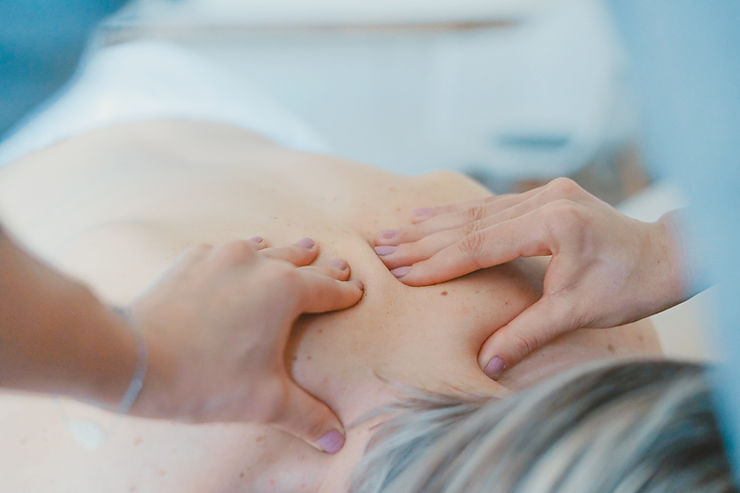"We've Got Your Back" -Massage Therapists
- Victoria Zorich

- Aug 24, 2020
- 5 min read

Back pain. One of most common reasons people see a doctor or miss work. Like any other pain, ranges in intensity from a constant ache, to sharp and shooting. Its onset can be as simple as getting too little exercise followed by a strenuous workout or the result of an accident. As people age, they become more susceptible to Low Back Pain. Mark Bailey, DO, PhD, professor of Neurology and Anesthesiology at the University of Alabama at Birmingham, details that "injuries, weight gain, physical deconditioning, arthritis in the spine, and loss of hydration and height in the discs, which increases the incidence of compression," are all factors that lead to Low Back Pain.
Low Back Pain is classified two ways, acute or chronic. Acute (short-term) lasts a few days, maybe a few weeks, before naturally resolving itself. It tends to be musculoskeletal, stemming from muscle injury, strain or a disruption in the way the spine, discs, or nerves connect. These pains are usually brought on by the strenuous workouts, incorrect lifting, or the result of an accident. Acute Low Back Pain tends to resolve itself within a few days with no residual loss of function. It is the most common form of Low Back Pain.
Chronic Low Back Pain persists for twelve weeks or more, and continues after the underlying cause or initial injury has been treated. Other than Acute Low Back Pain being the usual onset, Chronic Low Back Pain can be due to muscle sprains, strains, and spasms; disc degeneration or a ruptured or herniated disc; arthritis in the spine; Radiculopathy (nerve root compression in the spine); or spinal stenosis (a narrowing of the spinal canal that puts pressure on the spinal cord and nerves), among other causes. Roughly 20% of those with Acute symptoms end up developing Chronic Low Back Pain.

The Annals of Internal Medicine published a study in July 2017, comparing Yoga and Physical Therapy as effective for treating Chronic Low Back Pain, and found that they were comparable when it came to improving pain and functionality. Massage Therapy, Acupuncture, Chiropractic Therapy/Spinal Manipulation and other non-pharmacologic treatments have also been found to be beneficial.
By contrast, "physical inactivity makes back pain worse—the core muscles get weak, and they're what hold your spine straight," Dr. Bailey says.
For many suffering from Low Back Pain, Massage Therapy has been the GO TO source for pain reduction. The American Massage Therapy Association (AMTA) conducted a survey in 2009 stating; in the last five years 30% of people that had received at least one massage did so for reasons of pain management, injury rehabilitation, migraine control, or overall wellness. In 2014 a study of women with Chronic Low Back Pain indicated that participants who received Massage Therapy had a greater decrease in pain intensity and disability than participants who received Physical Therapy.
As more and more people are beginning to realize, Massage is more than just a trip to the spa for an hour of relaxation. It provides the body with immense benefits like:
Improved blood flow & circulation
Reduced blood pressure
Reduction of swelling and inflammation
Muscle and tissue relaxation
Increased flexibility
Stress reduction
Release of "feel good" hormones (endorphins)
Increased energy

“Integrative Therapies, especially Noninvasive Therapies like Massage Therapy, have a potentially big role to play in helping manage chronic pain,” says Cindy Steinberg, National Director of Policy and Advocacy for the U.S. Pain Foundation,
When it comes to dealing with Chronic Pain, Steinberg suggests health care providers take a different approach by trying Non-Pharmacological Therapies and Non-Opioid Pharmacological Therapies before prescribing opioids. Managing expectations is part of a Massage Therapist's job description. Clients living in pain come into treatments with this idea that one session will cure all their aliments. As a Licensed Massage Therapist (LMT), it is part of your job to provide realistic goals for how much pain relief is to be expected. Steinberg details pain reduction to her clients by saying, "if you can get a 10%- 20% reduction in your pain with a single treatment or activity limitation, and you find several treatments that give you this amount of relief, you can combine them and get a 40%-50% reduction in your pain. A 50% reduction in pain may mean the difference between staying at home or being able to go out and enjoy an evening with friends."
A 2017 American Massage Therapy Association (AMTA) article further discusses using Massage as a pain reliever not only as an alternative, but in replacement of opioids with Dr. Thomas, Ph.D. whom serves as the chair of the National Institute of Drug Abuse (NIDA) Prescription Opioids and Pain work group. Dr. Thomas is posed with the questions:
What role can Massage Therapy play in helping health care providers give patients alternatives to opioids for pain management?
Massage definitely can have a role in the treatment of pain. We know that Massage can activate “touch fibers” that in turn can inhibit pain signaling of nerves in the skin and muscle. Plus, Massage promotes blood flow and can reduce inflammation. And while all the ways Massage may work to reduce pain and promote healing are not understood, it is clear that Massage can be part of a more integrated treatment of various types of pain, especially pain originating in muscles. -Dr. David Thomas



.png)



Comments